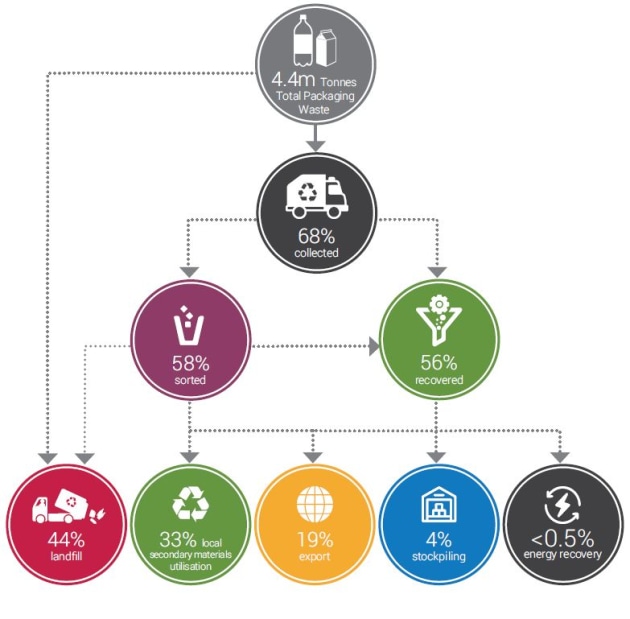There's a compelling need to improve packaging recovery and recycling rates across all material streams if we are to achieve the 2025 National Packaging Targets, according to a report released today.
Packaging Materials Flow Analysis (MFA) 2018, a new report developed by the Australian Packaging Covenant Organisation (APCO) in partnership with the Institute of Sustainable Futures (ISF), maps the current state of post-consumer packaging in Australia. It provides a comprehensive snapshot of the collection, sorting and recovery for post-consumer packaging in Australia (2017/18 financial year 1 July, 2017 to 30 June 2018) broken down by waste streams in paper, plastic, metal and glass.
The report highlights a compelling need to improve packaging recovery and recycling rates across all material streams. According to the findings outlined in the report, in 2017/18 Australia generated an estimated 4.4 million tonnes of total packaging waste, with 68% of this collected, and 56% of the collection total recovered by recycling efforts. This ranged from 32% for plastics and up to 72% for paper streams – highlighting “the significant opportunity to improve waste management practices to achieve higher recovery rates”, according to the report.
“To achieve the 2025 National Packaging Targets, we need to first understand the journey materials take along the entire supply chain and establish a baseline of data to measure change and interventions,” says Brooke Donnelly, APCO CEO, noting that this report is the first step in this process.”
“We can’t implement effective and meaningful changes to the system if we don’t first have a complete and accurate picture. A collaborative approach will be critical to building this,” Donnelly says
The report provides a comprehensive outline of the current journey of Australia’s packaging waste from bin to landfill or reprocessing, and identifies significant data and infrastructure challenges in the system and models five potential solutions for the future.

Dr Nick Florin, research director, Institute for Sustainable Futures (UTS) and co-author of the report commented: “There is great potential to step-up material recovery from the current overall recovery rate of 56% and at the same time increase demand for recycled materials to drive the transition to a circular economy for packaging.”
Florin says that APCO, as the central product stewardship organisation, is well placed to support this coordinated transition that involves cooperation between consumers, designers, recyclers and packaging manufactures.
The report's findings will be used to inform additional packaging and recycling research to develop a complete picture of the current system.
Brooke Donnelly adds: “The challenge ahead of us requires a complete transformation of the current system. Over the next 12 months, APCO will be leading an ambitious agenda of projects to build on the findings of the MFA. We look forward to working closely with all stakeholders as we transition to a circular model for packaging in Australia.”
The MFA Report is one of several APCO initiatives being conducted during the Foundation Phase of the targets (2019-2020) – the groundwork stage that focuses on research, engaging stakeholders and setting baselines and frameworks. Throughout 2018 APCO also facilitated a series of five, year-long industry working groups attended by more than 80 industry members from across the value chain and government to explore solutions to problematic packaging types (including glass, polymer coated paperboard (PCPB), soft plastics, biodegradable and compostable packaging, and expanded polystyrene).
In 2019 APCO will be co-ordinating 22 new projects to build on the findings of the MFA and the 2018 Working Groups. These will include further detailed research into packaging consumption and recycling to establish baselines for the 2025 targets, developing targeted design resources to improve packaging recyclability, and developing strategies to address problematic packaging, including plastics.
To read the full APCO Packaging Material Flow Analysis 2018, visit www.packagingcovenant.org.au.







